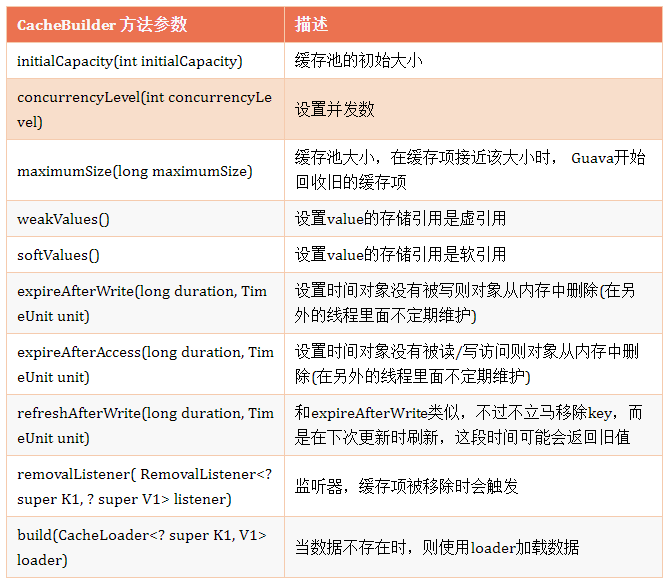工具篇:介绍几个好用的guava工具类
共 11092字,需浏览 23分钟
· 2021-07-13
1 前言
平时我们都会封装一些处理缓存或其他的小工具。但每个人都封装一次,重复造轮子,有点费时间。有没有一些好的工具库推荐-guava。guava是谷歌基于java封装好的开源库,它的性能、实用性,比我们自己造的轮子更好,毕竟谷歌出品,下面介绍下几个常用的guava工具类
LoadingCache(本地缓存)
Multimap 和 Multiset
BiMap
Table(表)
Sets和Maps(交并差)
EventBus(事件)
StopWatch(秒表)
Files(文件操作)
RateLimiter(限流器)
Guava Retry(重试)
2 guava的maven配置引入
<dependency>
<groupId>com.google.guava</groupId>
<artifactId>guava</artifactId>
<version>27.0-jre</version>
</dependency>
3 LoadingCache
LoadingCache 在实际场景中有着非常广泛的使用,通常情况下如果遇到需要大量时间计算或者缓存值的场景,就应当将值保存到缓存中。LoadingCache 和 ConcurrentMap 类似,但又不尽相同。最大的不同是 ConcurrentMap 会永久的存储所有的元素值直到他们被显示的移除,但是 LoadingCache 会为了保持内存使用合理会根据配置自动将过期值移除
通常情况下,Guava caching 适用于以下场景:
花费一些内存来换取速度
一些 key 会被不止一次被调用
缓存内容有限,不会超过内存空间的值,Guava caches 不会存储内容到文件或者到服务器外部,如果有此类需求考虑使用 Memcached, Redis
LoadingCache 不能缓存 null key
CacheBuilder 构造 LoadingCache 参数介绍

LoadingCache
V get(K key), 获取缓存值,如果键不存在值,将调用CacheLoader的load方法加载新值到该键中示例
LoadingCache<Integer,Long> cacheMap = CacheBuilder.newBuilder().initialCapacity(10)
.concurrencyLevel(10)
.expireAfterAccess(Duration.ofSeconds(10))
.weakValues()
.recordStats()
.removalListener(new RemovalListener<Integer,Long>(){
@Override
public void onRemoval(RemovalNotification<Integer, Long> notification) {
System.out.println(notification.getValue());
}
})
.build(new CacheLoader<Integer,Long>(){
@Override
public Long load(Integer key) throws Exception {
return System.currentTimeMillis();
}
});
cacheMap.get(1);
4 Multimap 和 MultiSet
Multimap的特点其实就是可以包含有几个重复Key的value,可以put进入多个不同value但是相同的key,但是又不会覆盖前面的内容
示例
//Multimap: key-value key可以重复,value也可重复
Multimap<String, String> multimap = ArrayListMultimap.create();
multimap.put("csc","1");
multimap.put("lwl","1");
multimap.put("csc","1");
multimap.put("lwl","one");
System.out.println(multimap.get("csc"));
System.out.println(multimap.get("lwl"));
---------------------------
[1, 1]
[1, one]
MultiSet 有一个相对有用的场景,就是跟踪每种对象的数量,所以可以用来进行数量统计
示例
//MultiSet: 无序+可重复 count()方法获取单词的次数 增强了可读性+操作简单
Multiset<String> set = HashMultiset.create();
set.add("csc");
set.add("lwl");
set.add("csc");
System.out.println(set.size());
System.out.println(set.count("csc"));
---------------------------
3
2
5 BiMap
BiMap的键必须唯一,值也必须唯一,可以实现value和key互转
示例
BiMap<Integer,String> biMap = HashBiMap.create();
biMap.put(1,"lwl");
biMap.put(2,"csc");
BiMap<String, Integer> map = biMap.inverse(); // value和key互转
map.forEach((v, k) -> System.out.println(v + "-" + k));
6 Table
Table<R,C,V> table = HashBasedTable.create();,由泛型可以看出,table由双主键R(行),C(列)共同决定,V是存储值新增数据:
table.put(R,C,V)获取数据:
V v = table.get(R,C)遍历数据:
Set<R> set = table.rowKeySet(); Set<C> set = table.columnKeySet();示例
// 双键的Map Map--> Table-->rowKey+columnKey+value
Table<String, String, Integer> tables = HashBasedTable.create();
tables.put("csc", "lwl", 1);
//row+column对应的value
System.out.println(tables.get("csc","lwl"));
7 Sets和Maps
// 不可变集合的创建
ImmutableList<String> iList = ImmutableList.of("csc", "lwl");
ImmutableSet<String> iSet = ImmutableSet.of("csc", "lwl");
ImmutableMap<String, String> iMap = ImmutableMap.of("csc", "hello", "lwl", "world");
set的交集, 并集, 差集
HashSet setA = newHashSet(1, 2, 3, 4, 5);
HashSet setB = newHashSet(4, 5, 6, 7, 8);
//并集
SetView union = Sets.union(setA, setB);
//差集 setA-setB
SetView difference = Sets.difference(setA, setB);
//交集
SetView intersection = Sets.intersection(setA, setB);
map的交集,并集,差集
HashMap<String, Integer> mapA = Maps.newHashMap();
mapA.put("a", 1);mapA.put("b", 2);mapA.put("c", 3);
HashMap<String, Integer> mapB = Maps.newHashMap();
mapB.put("b", 20);mapB.put("c", 3);mapB.put("d", 4);
MapDifference<String, Integer> mapDifference = Maps.difference(mapA, mapB);
//mapA 和 mapB 相同的 entry
System.out.println(mapDifference.entriesInCommon());
//mapA 和 mapB key相同的value不同的 entry
System.out.println(mapDifference.entriesDiffering());
//只存在 mapA 的 entry
System.out.println(mapDifference.entriesOnlyOnLeft());
//只存在 mapB 的 entry
System.out.println(mapDifference.entriesOnlyOnRight());;
-------------结果-------------
{c=3}
{b=(2, 20)}
{a=1}
{d=4}
8 EventBus
EventBus是Guava的事件处理机制,是设计模式中的观察者模式(生产/消费者编程模型)的优雅实现。对于事件监听和发布订阅模式
EventBus内部实现原理不复杂,EventBus内部会维护一个Multimap<Class<?>, Subscriber> map,key就代表消息对应的类(不同消息不同类,区分不同的消息)、value是一个Subscriber,Subscriber其实就是对应消息处理者。如果有消息发布就去这个map里面找到这个消息对应的Subscriber去执行
使用示例
@Data
@AllArgsConstructor
public class OrderMessage {
String message;
}
//使用 @Subscribe 注解,表明使用dealWithEvent 方法处理 OrderMessage类型对应的消息
//可以注解多个方法,不同的方法 处理不同的对象消息
public class OrderEventListener {
@Subscribe
public void dealWithEvent(OrderMessage event) {
System.out.println("内容:" + event.getMessage());
}
}
-------------------------------------
// new AsyncEventBus(String identifier, Executor executor);
EventBus eventBus = new EventBus("lwl");
eventBus.register(new OrderEventListener());
// 发布消息
eventBus.post(new OrderMessage("csc"));
9 StopWatch
Stopwatch stopwatch = Stopwatch.createStarted();
for(int i=0; i<100000; i++){
// do some thing
}
long nanos = stopwatch.elapsed(TimeUnit.MILLISECONDS);
System.out.println("逻辑代码运行耗时:"+nanos);
10 Files文件操作
数据写入
File newFile = new File("D:/text.txt");
Files.write("this is a test".getBytes(), newFile);
//再次写入会把之前的内容冲掉
Files.write("csc".getBytes(), newFile);
//追加写
Files.append("lwl", newFile, Charset.defaultCharset());
文本数据读取
File newFile = new File("E:/text.txt");
List<String> lines = Files.readLines(newFile, Charset.defaultCharset());
其他操作

11 RateLimiter
//RateLimiter 构造方法,每秒限流permitsPerSecond
public static RateLimiter create(double permitsPerSecond)
//每秒限流 permitsPerSecond,warmupPeriod 则是数据初始预热时间,从第一次acquire 或 tryAcquire 执行开时计算
public static RateLimiter create(double permitsPerSecond, Duration warmupPeriod)
//获取一个令牌,阻塞,返回阻塞时间
public double acquire()
//获取 permits 个令牌,阻塞,返回阻塞时间
public double acquire(int permits)
//获取一个令牌,超时返回
public boolean tryAcquire(Duration timeout)
////获取 permits 个令牌,超时返回
public boolean tryAcquire(int permits, Duration timeout)
使用示例
RateLimiter limiter = RateLimiter.create(2, 3, TimeUnit.SECONDS);
System.out.println("get one permit cost time: " + limiter.acquire(1) + "s");
System.out.println("get one permit cost time: " + limiter.acquire(1) + "s");
System.out.println("get one permit cost time: " + limiter.acquire(1) + "s");
System.out.println("get one permit cost time: " + limiter.acquire(1) + "s");
System.out.println("get one permit cost time: " + limiter.acquire(1) + "s");
System.out.println("get one permit cost time: " + limiter.acquire(1) + "s");
System.out.println("get one permit cost time: " + limiter.acquire(1) + "s");
System.out.println("get one permit cost time: " + limiter.acquire(1) + "s");
--------------- 结果 -------------------------
get one permit cost time: 0.0s
get one permit cost time: 1.331672s
get one permit cost time: 0.998392s
get one permit cost time: 0.666014s
get one permit cost time: 0.498514s
get one permit cost time: 0.498918s
get one permit cost time: 0.499151s
get one permit cost time: 0.488548s
因为RateLimiter滞后处理的,所以第一次无论取多少都是零秒
可以看到前四次的acquire,花了三秒时间去预热数据,在第五次到第八次的acquire耗时趋于平滑
12 Guava Retry
maven引入
<dependency>
<groupId>com.github.rholder</groupId>
<artifactId>guava-retrying</artifactId>
<version>2.0.0</version>
</dependency>
RetryerBuilder 构造方法

Retryer<Boolean> retryer = RetryerBuilder.<Boolean>newBuilder()
.retryIfException()
.retryIfResult(Predicates.equalTo(false))
.withAttemptTimeLimiter(AttemptTimeLimiters.fixedTimeLimit(1, TimeUnit.SECONDS))
.withStopStrategy(StopStrategies.stopAfterAttempt(5))
.build();
//Retryer调用
retryer.call(() -> true);
spring也有对应的重试机制,相关文章可以看看重试框架Guava-Retry和spring-Retry[1]欢迎指正文中错误(故事纯属虚构,如有雷同纯属巧合)
13 参考文章
Google guava工具类的介绍和使用[2] 重试框架Guava-Retry和spring-Retry[3] 超详细的Guava RateLimiter限流原理解析[4]
参考资料
重试框架Guava-Retry和spring-Retry: https://blog.csdn.net/zzzgd_666/article/details/84377962
[2]Google guava工具类的介绍和使用: https://blog.csdn.net/wwwdc1012/article/details/82228458
[3]重试框架Guava-Retry和spring-Retry: https://blog.csdn.net/zzzgd_666/article/details/84377962
[4]超详细的Guava RateLimiter限流原理解析: https://zhuanlan.zhihu.com/p/60979444
有道无术,术可成;有术无道,止于术
欢迎大家关注Java之道公众号
好文章,我在看❤️
